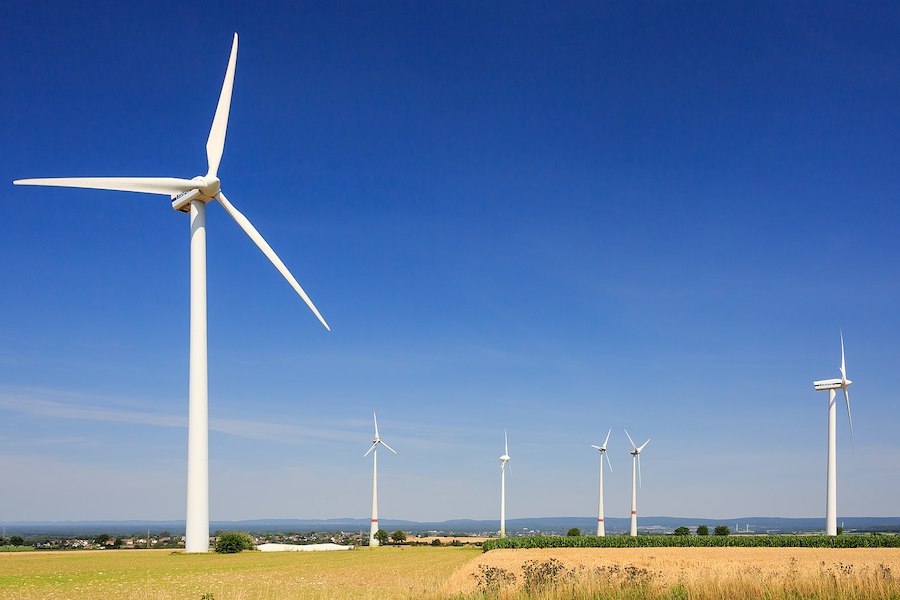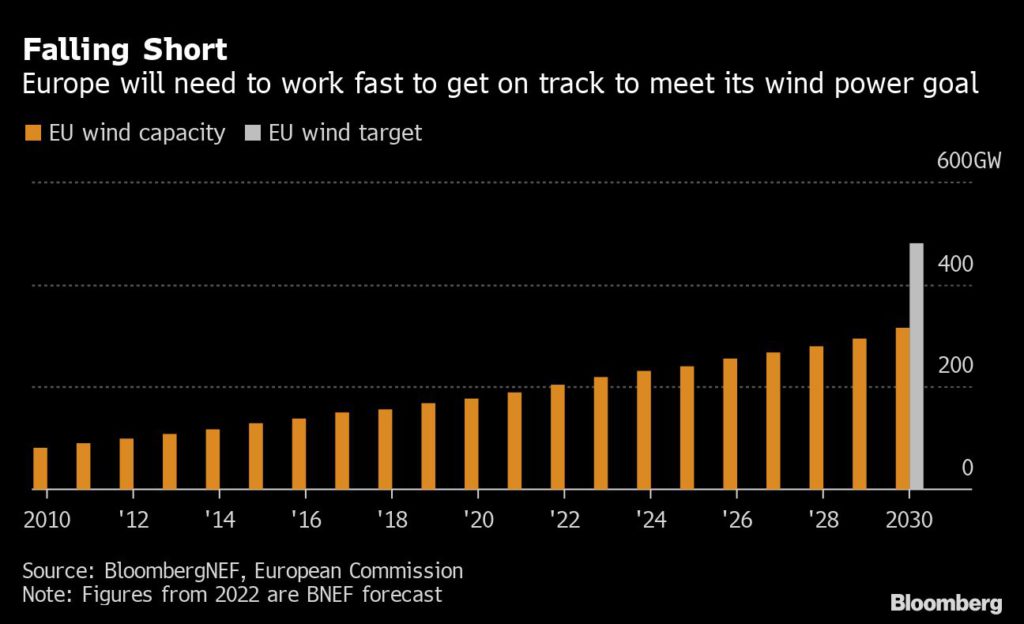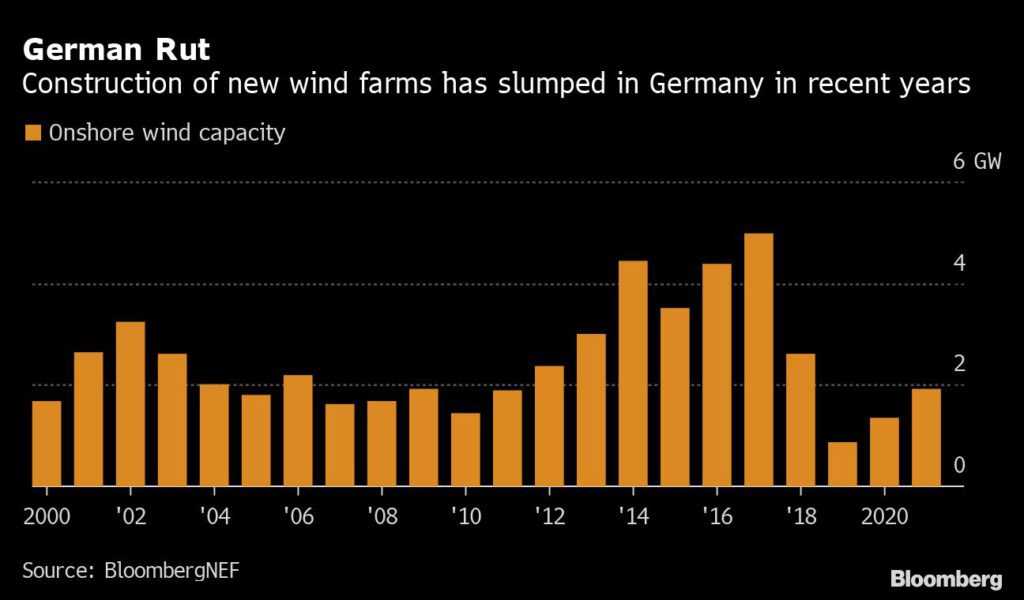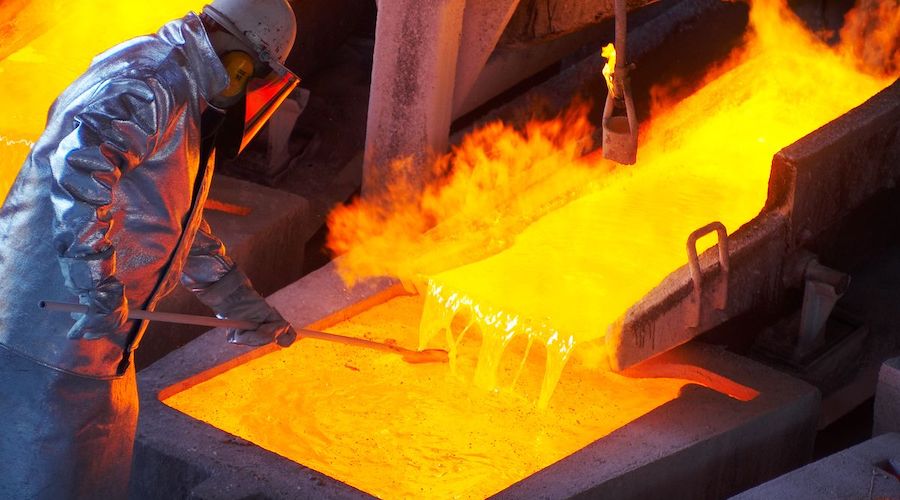Green fix to replace Russian gas is stymied by Europe’s red tape

Ten-thousand euros to print binders full of documents. Years in court to defend lawsuits. Hiring local contractors to lobby small-town bureaucrats.
Energy producers say these time-consuming bottlenecks are thwarting Europe’s push to ditch Russia and be more self-reliant.
European leaders promised to scale up the continent’s renewable-power capacity while reducing imports of Russian gas, but words move faster than permits. Builders say fast-tracking the energy transition means unravelling red tape and reconciling lofty, national climate ambitions with the limited capacity of most local authorities to implement them.
“There’s only one way to accelerate the supply of electricity into the system,” said Henrik Andersen, chief executive officer of Vestas Wind Systems A/S, the world’s largest wind turbine maker. “Accelerate the permitting.”
The EU’s plans necessitate a rapid expansion of renewables, particularly onshore wind farms, which tend to be most productive during winter, the peak season for consuming gas.
The bloc wants its wind power capacity to reach at least 480 gigawatts by 2030 — more than double the current level. But BloombergNEF forecasts the EU is set to reach only about two-thirds of that amount.
“The process is particularly inefficient and there’s huge room for improvement,” said Pietro Radoia, an analyst at BNEF. “It’s only getting worse.”

Russia’s biggest buyer of gas is Germany, where the government vowed to accelerate green-energy development through measures such as increasing the areas available for solar parks, expanding electric grids and adding wind farms at sea.
The 500-page package will help Germany almost double the share of renewables in gross energy consumption within a decade, Economy Minister Robert Habeck said.
“This is crucial to increase the pace of the expansion,” he said.
But the proposed legislation is far from a silver bullet, said Ron Schumann, a political adviser at the German Wind Energy Association. It’s unclear to him how the government will follow through on its promises to offer more land or nudge local officials to make faster decisions on permits.
“There are some changes that will help boost the wind-energy buildup,” Schumann said. “But the legislation we have now isn’t going to solve all the issues.”

That’s because many of the speed bumps are beyond the grasp of federal ministries in Berlin. There’s already an environmental law in Germany that says authorities should decide on applications within 10 months. But that timeline rarely is adhered to by county-level decision-makers, builders say.
Some inefficiencies are built into the system – such as a preference for paperwork over digital submissions. Earlier this year, EnBW Energie Baden-Wuerttemberg AG spent more than 10,000 euros ($10,536) to print 36,000 pages for an application to erect three wind turbines in its home state. The binders stretched the length of a conference-room table when placed side-by-side.
At that rate of almost 800 euros per megawatt of wind turbines, companies would spend about 8 million euros a year just on paperwork if the nation hits its target of adding 10 gigawatts of onshore wind capacity annually by 2030.
It now takes at least four years to get a permit approved by local authorities, a doubling since 2017, said Michael Class, head of generation portfolio development for EnBW.
And once the permit is in hand, opponents often challenge them in court. Those efforts rarely succeed but can add years to the building process, he said.
Sometimes the delay is so long the company must resubmit parts of the application because the turbines it planned to use became obsolete and were taken off the market.
Even so, critics of the inefficiencies recognize that permitting processes are in place for a reason and that officials must balance the need for more renewable energy with the concerns of the local populace.
“You don’t want to run roughshod over other interests in the vicinity,” said Olle Olsson, senior research fellow at the Stockholm Environment Institute. “The key challenge is to make these processes more efficient and more predictable.”
One remedy is to increase budgets for local authorities, Olsson said. Those workforces haven’t increased at the same pace as the demand to build wind farms, and sometimes there are only a couple of people in a small office to go through mountains of paperwork.
“Developers aren’t helping because they’re all filing for grid permits and environmental permits in areas that are already jammed,” BNEF’s Radoia said.
That’s triggering some corporate creativity. As its projects work through Italy’s system, Econergy Renewable Energy Ltd. hires area contractors to visit local officials — sometimes daily — and give them a nudge, Chief Executive Officer Eyal Podhorzer said.
“I’m just talking about local experts who know the right people, who can go to the municipality and go to the office and do whatever’s necessary to promote the project,” Podhorzer said in an interview.
Some countries already are taking action. Both Spain and Portugal have cut back on environmental approvals to help streamline solar and wind development on the Iberian Peninsula.
Solar farms take only a few months to build, meaning the measures could help boost electricity supply quickly and lower energy prices that have broken records in recent months.
But that’s only if Spain speeds up the process for connecting to the grid. More than 120 gigawatts of planned solar projects -– seven times the existing capacity — are waiting in line, the biggest backlog in Europe.
“Everyone is talking about less gas from Putin,” said Christoph Zipf, a spokesman at industry group Wind Europe. “This is only going to be possible if we build homegrown energies. When permitting isn’t taking so long, you can really scale.”
(By Will Mathis)
{{ commodity.name }}
{{ post.title }}
{{ post.date }}

Comments